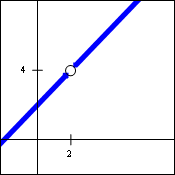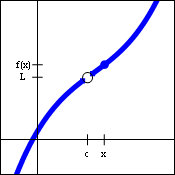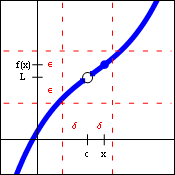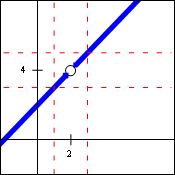
We use MathJax
Underlying all of calculus is the idea of a limit. In this section, we will explore what a limit is.
Through most of your earlier work in mathematics, you worked with some very nice functions. But there are quite a few functions which exhibit some rather unusual behaviors. Consider, for example, the function $f(x)=\dfrac{x^2-4}{x-2}$. Since the denominator cannot equal zero, the domain of this function is $x\ne 2$. Here is the graph of the function.

So how do we describe the location of the hole? If we don't need to refer to the function itself, we can simply say it is located at $(2,4)$ But if we want to refer to the hole as it relates to this function, things are somewhat more problematic. Note that $f(2)\ne 4$, because $f(2)$ does not exist, so a simple functional value is not available. Since the hole keeps us from referring to the point itself, we could say that the points near the hole have coordinates near the coordinates of the hole. In other words, the behavior of the function near the hole is important.
Let us suppose now that we have a generic function $y=f(x)$ with a generic point $(x,f(x))$, and with a hole located at the point $(c,L)$. Its graph is given below.

To describe the behavior of the function near the hole, we will speak in terms of the point as it approaches the hole. We would like to say:
That statement roughly describes what is happening, and our notation for this statement, $\lim\limits_{x\to c} f(x)=L$, reflects these very words. The symbol $\lim$ is an abbreviation for the word limit, which is the mathematical term for the concept we are now developing. But the statement doesn't give us much help in turning the situation into something that can be evaluated mathematically. Here is a similar statement:
This may appear almost identical, but the word "close" does suggest a way to measure (using numbers) what is happening. So here is another statement:
Distance is something that is well defined in mathematics. For our situation, we are talking about distances along each axis, and a two-dimensional distance can be found by using absolute values. So we can now write:
So how do we describe small? It would appear that we have simply moved our original difficulty of a function being "close" to a hole to a new realm, where the distance is "close" to zero. But now, we can define a couple of values (delta and epsilon) that will help force the distances to remain near zero.
In fact, we are saying that our distances ought to be less than these values. Both $\delta$ and $\epsilon$ will need to be positive, because our distances are less than those values, and distances cannot be negative. Often, $\delta$ and $\epsilon$ are referred to as infinitesimals, because they are intended to represent very small quantities. In some sense, they can be thought of as tolerances, although as we consider them now, they have nothing to do with error, only closeness. And how do we interpret these values on the graph? Let us update our picture.

In this picture, $\delta$ is the distance along the $x$-axis from the value $c$ to either of the vertical dashed lines. In other words, the vertical dashed lines are located at $c-\delta$ and at $c+\delta$. Since $x$ is between those vertical dashed lines, the statement $|x-c|<\delta$ is being displayed.
Similarly, $\epsilon$ is the distance along the $y$-axis from the value of $L$ to either of the horizontal dashed lines. In other words, the horizontal dashed lines are located at $L-\epsilon$ and at $L+\epsilon$. Since $f(x)$ is between those horizontal dashed lines, the statement $|f(x)-L|<\epsilon$ is also being displayed.
These dashed lines also create a rectangle. Notice that the function exits the rectangle by crossing the left and right sides of the rectangle, and not the top or bottom of the rectangle. This was quite intentional. If we allowed the function to leave the top or bottom of the rectangle, we could conceivably have a much larger gap between the two halves of the function than just a hole we have now. To maintain this relationship between the function and the rectangle, two things are required.
So here is our definition.
So how do the concept and the definition relate to our original example of the function $f(x)=\dfrac{x^2-4}{x-2}$? Conceptually, we would say that $\lim\limits_{x\to 2} f(x)=4$, because as the $x$-values approach 2, the function itself approaches the "hole" in the graph, and the $y$-values will be approaching 4. In fact, although the hole is there, the concept allows us to avoid dealing with it entirely.

As we compare the definition to the graph, we see five parts: